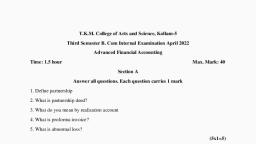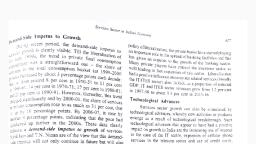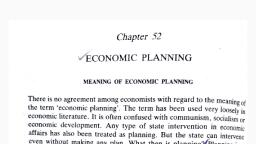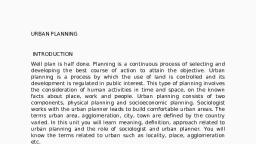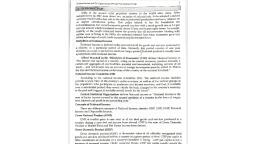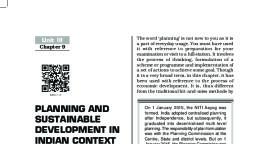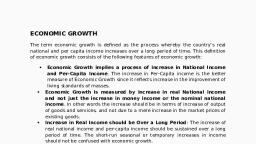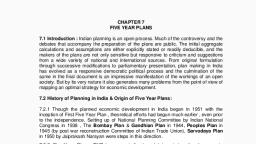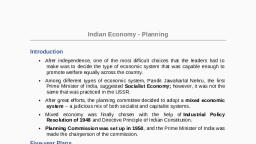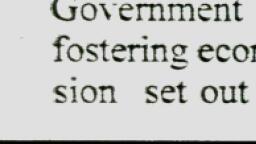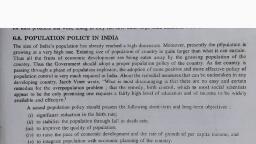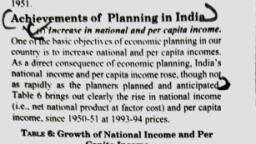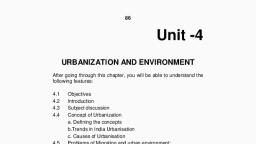Page 1 :
55, Chapter, ECONOMIC PLANNING, RATIONALE, FEATURES AND, OBJECTIVES, in this chapter, we propose to address the following, has to be based on social benefits rather than private, profitability., questions:, What exactly economic planning means in India?, What is the rationale of economic planning in a, developing economy like India?, The UN Conference on Planning held in 1965 had, recommended adoption of economic planning in, underdeveloped countries on similar grounds. The UN report, asserted, "It is an integral task of planning to achieve the, best possible use of scarce resources for economic, development. The need for using appropriate criteria for, selecting projects arose because the market prices of such, factors of production as labour, capital and foreign exchange, deviated substantially from their social opportunity costs, and were not, therefore, a correct measure of the relative, scarcity or abundance of the factor in question."1, • How planning works in practice?, What were the main features and objectives of, economic planning in India?, THE RATIONALE FOR PLANNING, 1. Limitations of the market mechanism. The, most important rationale for adopting planning is the limitations, of the market cconomy. When India won Independence in, 1947, it was very backward economically and the general, consensus was that planning was required for the economic, development of the country. Relying entirely on the market, mechanism, this country could not even hope to come out, of the low level equilibrium trap in which it had fallen during, the period of its colonial subjugation., D.R. Gadgil had aptly summed up the reasons why, economic planning was adopted in the developing countries, like India in the following words, “Planning for economic, development is undertaken presumably because the pace, of direction of development taking place in the absence of, external intervention is not considered to be satisfactory, and because it is further held that appropriate external, intervention will result in increasing considerably the, pace of development and directing it properly."2, 2. The need for social justice. The experience of, many free enterprise economies shows that the gains of, economic growth do not necessarily trickle down. In fact,, IMPORTANT FEATURES OF INDIAN PLANS, market forces operate in such a manner that further, concentration of economic power takes place and the growth, The main features of planning as practised in India, have been as follows:, 1. Indicative economic planning. The Indian plans, did not carry an element of compulsion or inevitability as, found in the planning of socialist countries. The Indian, plans generally laid down targets even for those sectors of, the economy over which the government had, For instance, practically the whole agricultural sector in, India is in private hands but the government persisted on, laying down detailed targets for this sector. However, since, the management of farming and other agricultural activities, had all along rested in private hands, the government was, never too sure of achieving the targets laid down in the, plans., The main reason for this state of affairs was the, a fruitful manner., control., 3. Resource mobilisation and allocation in the, presence of the mixed economy. Such a system gives, 685, developing countries, the choice of development projects, 1
Page 2 :
686, Indian Economy, ample incentives to the private capital and uses few controls., There is no compulsion or inevitability in any work though, there might be some regulation and regimentation of, economic activities. As against the private sector, it is, indeed more essential to accomplish the targets laid down, for the public sector. However, even here there was no, compulsion as such. This shows that Indian planning has, been indicative economic plannin, inducement only., plans laid stress on rapid economic growth more than any, other objective, the Fifth and Sixth Plans attached great, importance to self-reliance, generation of employment and, removal of poverty. In the Seventh Plan, modernisation, was stressed. The Eleventh Plan focused on inclusiveness, of growth' while the Twelfth Plan talks of inclusiveness, and sustainability of growth'. However, the new government, at the Centre which assumed office in 2014 has now, totally abandoned economic planning and has dismantled, the Planning Commission. The place of Planning, Commission has been taken over by NITI Aayog (for, details, see Chapter 61)., or planning by, 2. Physical planning. Economic planning may be, either (i) physical planning, or (ii) financial planning. The, former implies allocation of resources in terms of men,, material and power to accomplish the targets laid down in, the plan documents. The latter implies the provision of, financial resources to make this possible. Both are, complementary and proceed side by side in rational planning, system. However, both P.C. Mahalanobis and Pitambar, Pant who influenced the framing of the Second Plan most, Economic Growth, were physical planners. They believed that "provided the, investments were technically feasible, savings ought to be, forthcoming somehow."3 The obviously wrong assumption, that "What is physically possible is financially possible, too"4 resulted in shaping Indian planning primarily as physical, planning., 3. Indian planning has been social planning. Indian, planning has all along focused on social planning rather, than pure economic planning. It is precisely on account, of this factor that its economic character became distorted., Economic growth has always remained in focus as, the main objective of Indian Five Year Plans. Even when, some other objectives were stated emphatically in some, Five Year Plans, the objective of growth retained its pre-, eminent position. High priority to economic growth in, Indian plans seemed justified, particularly when we view it, in the context of long period of stagnation in the nineteenth, and early twentieth century. The economy of the country, had received severe jolt under the British on account of, massive drain of wealth from India. In this period while the, European, underdevelopment. Therefore, once this country got, Independence, the unequivocal choice of the decision-, makers was for economic growth., countries, developed. India, suffered, Because of its social nature, the impact of all those factors, that affect political environment has been very much visible, on Indian planning as well. As far as the political environment, is concerned, the impact of the capitalist class, the zamindars, and the prosperous large farmers has always been very, much in evidence. The government policies were formulated, keeping the interests of these classes in view. How else can, one account for the failure of land reforms, increase in the, concentration of wealth and economic power, expansion in, the activities of large business houses, etc.?, The Earlier Phase: 1951 to 1980. The era of economic, planning ushered in 1951. The First Five Year Plan covering, the period from 1951 to 1956 had a target of 2.1 per cent, per annum increase in national income. This target, in fact,, was very modest and even with its realisation there could, be no increase in per capita national income. The performance, of the plan, however, was better and over the five-year, period national income recorded a 4.6 per cent per annum, increase. The Second Five Year Plan envisaged a target of, 4.5 per cent per annum increase in national income. From, a quantitative point of view this target was not significantly, higher than the actual growth performance during the First, Plan period. The Second Plan was, however, different from, the First Plan in terms of its objectives. Its basic framework, was based on the Mahalanobis strategy of development,, which gave the highest priority to heavy industries. The, implementation of this policy involved rapid development of, the public sector. The actual growth rate during the Second, Plan, however, turned out to be a little lower than the, targeted rate. The national income rose at the rate of 4.1 per, OBJECTIVES OF ECONOMIC PLANNING, The long-term objectives of economic planning, as, spelt out in various Plan documents, have been as follows:, (1) economic growth, (2) self-reliance, (3) removal of, unemployment, (4) reduction in income inequalities,, (5) elimination of poverty, (6) modernisation, and, (7) inclusiveness and sustainability of growth. Some of, these objectives were elaborately discussed in the Second, and Third Five Year Plans. In the subsequent plans, they, were simply reiterated. Various plans, however, did not, place equal emphasis on these objectives. Whereas earlier, cent per annum., The Third Plan aimed at securing an increase in, national income of 5.6 per cent per annum. In totality the, 2
Page 3 :
688, Indian Economy, and a rapid growth in the services sector. The level of, investment is generally considered a major determinant of, growth and, in this, the Sixth Plan expectations were, fulfilled., (2002-03), India's GDP in the four years ending 2006-07, grew annually at 8.6 per cent making it the world's fastest, growing economy after China. This generated a lot of, euphoria in official circles and the government claimed that, *the economy has moved decisively to a higher growth, phase'.5 This emboldened the government to fix 9.0 per, cent per annum economic growth target for the Eleventh, Plan. As against this, the actual rate of growth in the, Eleventh Plan was 7.5 per cent per annum. The CSO, released a new series of national accounts with a revised, The Seventh Plan aimed at 5.0 per cent per annum, increase in GDP while actual achievement was 5.8 per cent, per annum. Thus, the overall rate of growth exceeded the, target. In isolation, this may look quite impressive. However,, when we examine as to how the overall rate of growth of, 5.8 per cent per annum was realised during the Seventh, Plan period, the situation appears to be less encouraging., The country did not register a steady rate of growth during, the Seventh Plan period. There were marked variations in, the rate of growth registered in different years of the plan., The growth process of the 1980s, in spite of an, improvement in the average GDP growth rate has been, widely criticised. One major criticism of this growth process, which involved high fiscal deficit was that it was, unsustainable as it put pressure on balance of payments, and also led to inflation. Another major criticism was that, it involved inefficient utilisation of resources., base year of 2011-12 on January 30, 2015. According to, this series, the rate of growth of GDP at constant (2011-, 12) prices was as high as 8.0 per cent in 2015-16, 7.1 per, cent in 2016-17 and 6.7 per cent in 2017-18. In fact, during, some of the recent years, India was the fastest growing, major economy of the world., Self-Reliance, The year of 1990-91 was not bad in terms of growth, though in this year the economic crisis which deepened in, 1991-92 had already begun. In 1990-91, GDP registered, 5.3 per cent increase. This could not be sustained in, 1991-92 as in this year adverse effects of the economic, crisis arrested the overall growth process. The rate of, growth of GDP in this year was only 1.4 per cent and both, agricultural and industrial sectors registered negative growth, rates of -1.4 and -0.1 per cent respectively., About six-and-a-half decades ago on the eve of the, First Plan, India was dependent on foreign countries at, least in three respects. First, despite the fact that Indian, economy was essentially agrarian, the output of foodgrains, was not adequate and the country imported big quantities, of foodgrains from the USA and some other countries., Second, on ассоиnt of virtual nom-еxistence of basic, industries, transport equipment, machine tools, heavy, engineering goods, electrical plant and machines and, many other capital goods had to be acquired from developed, countries. Third, saving rate being very low, foreign aid, had to be obtained in order to step up the investment rate, in the country., The Eighth Plan kept a target of 5.6 per cent per, annum GDP growth while actual achievement was higher, at 6.5 per cent per annum. This satisfactory performance, on the growth front made proponents of economic, liberalisation in the country quite optimistic. In the official, circles also, the decision-makers contended that the, liberalisation package had put the Indian economy on the, high growth path., No one disputes that trade between two equal partners, on purely commercial terms is beneficial to both. This may, not, however, be correct in respect of underdeveloped, countries trading with developed countries from an unequal, bargaining position. It has been observed in many cases that, developed countries while supplying essential commodities, like foodgrains, machinery and other capital equipment to, underdeveloped countries, attempt to take full advantage of, their strong bargaining position and extort exorbitant prices, for their products. Often exports of these and other essential, goods are used as political weapons to blackmail the Third, World countries. Therefore, if some underdeveloped country, seriously desires to keep its growth activity free from, political pressures of other countries, it has no choice but, to become completely self-reliant in food and capital, equipment. Further, it has also to minimise its dependence, in respect of aid from other countries and the institutions, like the IMF and the World Bank., The rate of growth in the Ninth Plan was 5.4 per cent, per annum as against the target of 6.5 per cent per annum., The Planning Commission put the blame for this poor, performance (vis-à-vis the target) on low agricultural growth, in three out of five years, reduced demand for industrial, goods and the consequent reduction in the growth rate of, the industrial sector, and slowdown in the world economy, that adversely affected the level of exports. While the Tenth, Five Year Plan aimed at achieving an annual average growth, rate of 8 per cent over the period 2002 to 2007, the actual, rate of national income growth in this plan was 7.6 per cent, per annum. If one leaves out the first year of the plan, Broadly these were the reasons why self-reliance was, adopted as a major objective of economic planning in this, 3
Page 4 :
reliant over a de cade or so. The concept of self-reliance, adopted in the Plan was. however, narrow. Self-reliance, stated that the country would endeavour to become self-, foreign aid but also decided to do away with concessional, COuntry made progress along the expected lines during the, first three years of the Plan. However, in the fourth year of, the government's commitment to reduce its dependence on, necessitated by the drought and sharp rise in the international, the objectives of economic planning in all the Five Year, Plans, but it never got a high priority. Ashok Rudra, with the rising number of unemployed, poverty expands., pyments position mainly due to large imports of foodgrains, Unemployment problem requires an immediate, payments. Also, because of the hot money inflows the, products are highly volatile and any unexpected spurt in, Country has now become extremely vulnerable to the designs, imports of foodgrains from the USA under PL 480. The, Country. The emphasis on self-reliance was not much in the, 2sistance. In the Fourth Plan, the objective of self-reliance, fist two plans. In the Third Plan for the first time it was, the Plan, the country faced a deterioration in its balance of, them can cause severe strain on the country's balance of, Nolution for the elimination of poverty. It is observed that, Removal of unemployment was thus mentioned as one of, LLONOMIC Planning, Rationale, Features and Objectives, asserts that the government never had an employment, policy. It also did not set a target date "by when any able-, bodied person who wants to work and make an honest, living can be assured of a job that would offer him at least, a minimum subsistence. This explains why unemployment, has not decreased over the years., as overcoming the need for external, defined merely, For most of the period of planning, the Planning, Commission did not visualise the question of employment, generation separately from investment programmes. It was, believed that as investment increased, employment would, also grow. In the Third Plan document, while discussing, the objectives of economic planning the Planning Commission, had argued that as national income grows in response to, increased investment and development outlay, the demand, for labour rises and employment expands. This is a very, simplistic view. The main weakness of this approach is that, it ignores the fact that an increase in investment does not, automatically create larger employment. For the growth of, employment besides an increase in investment, the choice, of techniques should also be correct. This is possible only, if before finalising each investment project, its employment, potential is carefully studied from a technical point of view., Decisions taken in purely macroeconomic framework will, be of little avail. Keeping in view the requirements of, different regions, sectors and economic classes, separate, employment plans have to be framed for cach one of them., of imports., prices, Under the Fifth Plan for tackling the balance of, nayments problem, two pronged strategy was adopted in the, form of export promotion and import squeeze. This policy, nd unexpectedly large private remittances considerably, improved the balance of payments position. However, during, 25, es, the 1980s liberalisation in the foreign sector led to severe, strains on the balance of payments and the country's foreign, ic, exchange reserves declined to $ 2,236 million in March, 1991. The government thus resorted to economic reforms. It, nd, is now hoped in the official circles that with the correction, te, and would ultimately realise the goal of self-reliance., It is now generally agreed that in the field of self-, reliance, India has two achievements to its credit. First,, the, el, of macroeconomic imbalances and structural reforms, the, cconomy in the future would tread on a high growth path, Creation of Fresh Jobs in an Inadequate Number., How incorrect was the approach of the government in, respect of employment is evidently clear from the fact that, it did not even attempt to create as many jobs as were, required by the fresh labour force coming to the labour, market. Consequently, at the end of each plan period the, unemployment backlog was greater than at the beginning, of the plan. For example, the backlog of usual status, unemployment on the eve of the Sixth Plan was estimated, around 12 million (based on 32nd Round of the NSS). The, net addition to the labour force in the age group 5+ during, 1980-85 was estimated to be around 34 million. These two, together indicated the overall magnitude of employment to, be generated during the Sixth Plan period. It is clear that, employment could not be generated on this scale during, 1980-85, and as a consequence the backlog of usual status, unemployment on the eve of the Seventh Plan was around, 13.9 million (based on 32nd round of the NSSO). Backlog, of unemployment in April 1990 was 13 million in terms of, usual status and 20 million in terms of daily status.", Ders, pad, qual, s that, dities, country is now almost self-sufficient in food. Second,, in the growth of iron and steel, machine tools and, ent to, Meavy engineering industries, this country has made, Considerable advancement towards self-reliance in capital, quipment. In totality, however, the goal of self-reliance, proved to be elusive. International prices of petroleum, Thid, f global finance capital., e fram, Removal of Unemployment, Mize but, In 1993-94, the labour force was 381.94 million while, workforce was 374.45 million which implies that the number, of unemployed people was 7.49 million. As a ratio of labour, force, this works out at 2.0 which therefore was the, 4, Prias, capial
Page 5 :
690, Indian Economy, unemployment rate in 1993-94. The number of unemployed, rose to 8.97 million in 1999-2000 and 11.17 million in 2004-, 05. As a result, the unemployment rate also rose to 2.2 per, cent in 1999-2000 and further to 2.4 per cent in 2004-05., objective arose out of the conviction of the planners tha, economic growth will automatically reduce income, inequalities. Since the Eighth Plan like the Seventh Plan, made no reference to the objective of reduction in income, inequalities, it would not be wrong to infer that it has now, been completely abandoned by the government., The situation improved somewhat over the period 2004-05, to 2009-10 with the number of unemployed people declining, to 9.84 million and the unemployment rate to 2.1 per cent., In 2011-12, the labour force was 483.75 million while, workforce was 472.91 million. Thus, the number of, The g, Failure on Income Distribution Front. Data provided, in Chapter 16 on "Income Inequalities in India" brings out, the complete failure of the government on the income, redistribution front. As stated therein, the inequality in India, has risen substantially from the 1980s onwards, following, profound transformations in the economy that centred on, unemployed people was 10.84 million. The unemployment, rate in this year was 2.2. According to an estimate of ILO, (International Labour Organisation), the number of, unemployed people in India in 2017 was 18.3 million (which, was 9.49 per cent of world's unemployed population) and, the unemployment rate was 3.5 per cent. The ILO Report, estimates the unemployment rate to remain unchanged at, 3.5 per cent in 2019 with the number of unemployed people, going up to 18.9 million (this would be 9.76 per cent of, world's unemployed population in that year).$, N will, the implementation of deregulation and opening-up reforms., In fact, since the beginning of deregulation policies in the, Aost exp, 1980s, the top 0.1 per cent earners have captured more, growth than all of those in the bottom 50 per cent combined., The massive income inequalities that presently exist in the, Indian economy are further highlighted by the fact that the, richest 1 per cent Indians owned 58.4 per cent of the, ANtN of, country's wealth in 2016 while the share of the top 10 per, outpu, Reduction in Income Inequalities, are bac, cent was as high as 80.7 per cent. The plight of the poor, would be clear from the fact that the bottom half of the, ation, population owned a mere 2.1 per cent of the country's, ipuktio, Reduction in income inequalities has been mentioned, as one of the objectives of economic planning in India., However, in terms of priority it always got a very low, place. It is probably on account of this reason that neither, the plan documents, nor any other publications of the Planning, Commission ever provided estimates of the inequalities in, income and wealth distribution. Pramit Chaudhuri is perhaps, right in his assertion that Indian plans have never made any, serious attempt to redistribute income and wealth., wealth in 2016.10, to bot, The Planning Commission had spelt out its approach, in respect of income inequalities in the Fourth Plan. In its, opinion, fiscal measures at best can reduce disposable income, at the top and thus their importance for eliminating income, inequalities is limited. It stressed the need for raising the, living standards of the poor by accelerating the pace of, growth on the assumption that the gains of development, will percolate downward. Interestingly in the Fifth Plan, though removal of poverty was mentioned as a major, objective, only a passing reference was made to the problem, of income inequalities. The Sixth Plan reiterated the need, for removal of poverty, but did not spell out concrete, measures to be followed for eliminating income inequalities., The Plan document simply hoped that fiscal policy, industrial, licensing, monopoly control measures and additional, employment opportunities to be created during the Plan, period should be able to reduce disparities in income, distribution. The Seventh Plan did not make even a passing, The basic cause of income inequalities in the countryside o, is inequality in the ownership of agricultural land. Agricultural he Pk, labourers do not possess any land and belong to the poorest onom, strata of the society. Small farmers with little land in their d in, possession produce only that much which is hardly enough elow, for subsistence living. In contrast, incomes of big farmers 190, are not only high, but are also steadily rising. Apart from the, economic surplus they appropriate, they manage to get, credit on easy terms from cooperative credit societies, rural, banks, etc. for investment purposes. This has enabled them, to introduce productivity raising technology in agriculture,, as a consequence of which their incomes have registered a, steep rise. However, Indian plans with their main focus on, growth did little to prevent these continuously growing, income inequalities in rural areas., From rapidly growing assets of the big business, houses, it is obvious that income inequalities have been, increasing in urban areas as well. Anti-monopoly measures, were totally ineffective in reducing income inequalities in, the urban areas. In fact, because of increasing liberalisation, in recent years and more and more incentives to private, corporate sector to expand its activities and generate profits,, income inequalities in urban areas have increased., Th, reference to this objective. All this shows that the objective, of reduction in income inequalities was accorded a very, low priority in economic planning. The neglect of this, Elimination of Poverty, Until the late 1970s decision-makers in the government, and the Planning Commission were of the view that the, This u, 是員豆學孝。, he Plan, olousl, Wigaric, Rour, 15 on, per, or urb
